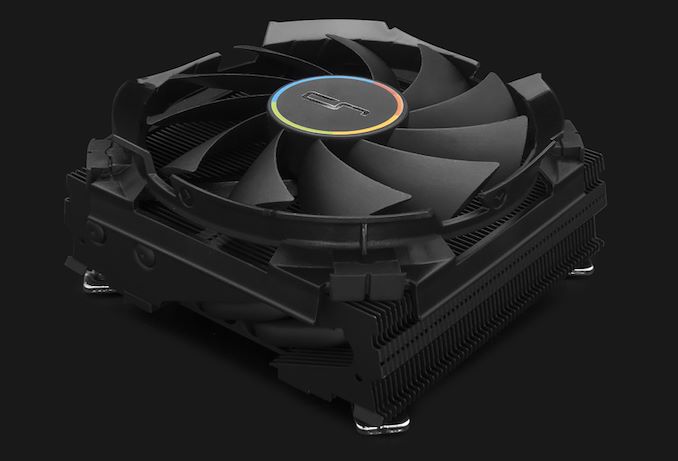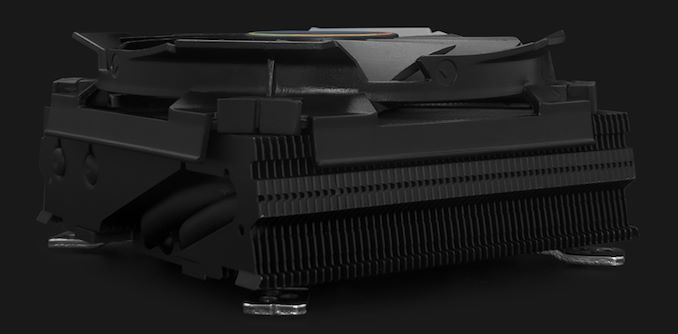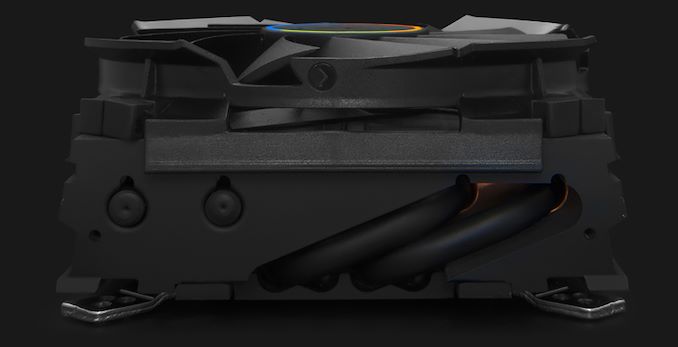Cryorig C7 G Is A 47mm Low-Profile Cooler with a Graphene Coating, Rated for 125W
by Anton Shilov on September 26, 2019 3:00 PM EST- Posted in
- Cooler
- AMD
- Intel
- Cases/Cooling/PSUs
- cryorig

Cryorig has introduced its low-profile CPU cooling system for small form-factor PCs that can dissipate up to 125 W. Featuring a 47-mm z-height and a 97-mm depth/width, the Cryorig C7 G is among the smallest coolers for higher-end processors available today. To make C7 G's high performance possible, Cryorig had to apply graphene coating on the heatsink.
As owners of SFF PCs demand higher-performance components, cooling designers are creating low-profile coolers rated for TDP levels of 95 W of higher. To maximize efficiency of such devices, manufacturers use copper for heatsinks, many heat pipes, and large fans. Cryorig decided to go one step further and applied graphene coating to the radiator’s fins. Thermal conductivity of graphene is in the range of 3000 - 5000 W/mK at room temperature (according to Graphene-Info), which is considerably higher than thermal conductivity of aluminum (250 W/mK at 25ºC) or copper (401 W/mK at 25ºC), so applying it on the fins could theoretically improve cooling performance.
Just like regular Cryorig’s C7, the model C7 G features four 6-mm heat pipes and a 97-mm PWM fan with 11 curved blades that rotates at a speed of 600 – 2500 RPM producing airflow of up to 40.5 CFM as well as rated for a maximum load noise level of 30 dB(A).
As far as compatibility is concerned, the Cryorig C7 G cooling system can work with all modern platforms from AMD and Intel, including the latest AM4 and LGA1155 sockets.
| The Cryorig C7 G Specifications | ||||
| C7-G | ||||
| CPU TDP | 125 W | |||
| Material | Copper base, graphene covered fins | |||
| Dimension with Fan | 97 mm (W) × 47 mm (H) × 97 mm (D) | |||
| Heat Pipes | 4 × 6 mm heat pipes | |||
| Air Pressure | ~ 1.36 mm H2O | |||
| Air Flow (CFM) | 40.5 CFM | |||
| Speed | 600 ~ 2500 RPM | |||
| Noise | up to 30.2 dBA | |||
| Type of Bearing | ? | |||
| Life Expectancy | ? | |||
| Weight | 673.5 grams | |||
| Compatibility | AMD | AM4/FM2+/FM2/FM1/AM3+/AM3/AM2+/AM2 | ||
| Intel | LGA1151/1150/1155/1156 | |||
Cryorig’s C7 G cooler will be available in Japan starting September 28 for ¥9,960 without sales tax ($92.50), which is certainly higher than average for an air cooler. Evidently, graphene coating is expensive and dissipating up to 125 W using a cooling system featuring a 47 mm z-height is a unique capability, so the price can be justified. The unit is already listed on the company’s website, so its launch in other countries is imminent.
Related Reading:
- ID Cooling IS-50X Low-Profile SFF Cooler, Rated for 130 W TDP
- ID Cooling Unveils IS-30 Low-Profile 30-mm Cooler for 100 Watt CPUs
- SilverStone Launches 33mm Nitrogon NT08-115XP CPU Cooler for Ultra-Thin PCs
- 3-Way Low Profile CPU Cooling Shoot-Out: Reeven, Phanteks, & Noctua
Source: Cryorig (via Hermitage Akihabara)












57 Comments
View All Comments
Sweetbabyjays - Thursday, September 26, 2019 - link
They most likely applied a textured (perhaps microscopic) graphene coating to increase the surface area.If they didn't increase the surface area with the graphene the only way i can see them possibly improving the heat transfer from the metal heat sink to the air is by coating the metal to prevent oxidation.
wilsonkf - Thursday, September 26, 2019 - link
It seems that coating graphene change some surface properties of metal and thus improve heat transfer. The high heat conductivity of graphene layer itself is not a major contributing factor.Sttm - Thursday, September 26, 2019 - link
Very cool. I want to see a U12A from Noctua coated in it.jrs77 - Thursday, September 26, 2019 - link
Exactly my thoughts. Simply adding another layer oaf somethng doesn't improve the cooling-abilities at all, as the part with the least conductivity is still the bottleneck of the whole design.Microstexture like seen on sinks with a lotuseffect coating would make hte most sense to increase surface-area.
haukionkannel - Friday, September 27, 2019 - link
That Also would increase dust collecting abilities of the surface... so if there Are any benefits, those will dissappear very quicly, but matte black looks good ;)bcronce - Sunday, September 29, 2019 - link
"Simply adding another layer oaf somethng doesn't improve the cooling-abilities at all"Not true. They've been doing this with aluminum finned copper-core heatsinks for quite a few years. First heatsinks where just aluminum, but it didn't conduct heat as well. Then they tried all copper, which was better but heavier. Then some company created a computer heatsink with a copper-core that had aluminum or aluminum coated fins because aluminum thermally interfaces with air better than copper, but copper has lower heat resistance. Best of both worlds.
This used to be common knowledge in the computer geek community.
Lochtror - Tuesday, October 1, 2019 - link
pretty sure it was copper core and aluminum fins for production cost and weight reasons. that was the time i build computers and i remember the all copper cooler still had a better standing and higher price. with talk about the cost difference in the material.peevee - Tuesday, October 1, 2019 - link
""Simply adding another layer oaf somethng doesn't improve the cooling-abilities at all"Not true. They've been doing this with aluminum finned copper-core heatsinks for quite a few years. First heatsinks where just aluminum, but it didn't conduct heat as well."
Your example is NOT ADDING a layer on top, it is replacing part of the material (Al) with another material.
deil - Friday, September 27, 2019 - link
Am I right that they managed to make it ~40% better? if so, it means top gaming laptops will soar.PeachNCream - Friday, September 27, 2019 - link
They may as well have said it was coated in pixie dust and unicorn pee because the implication that their use of what amounts to graphene as paint as an improvement is just as much of a deluded fantasy.